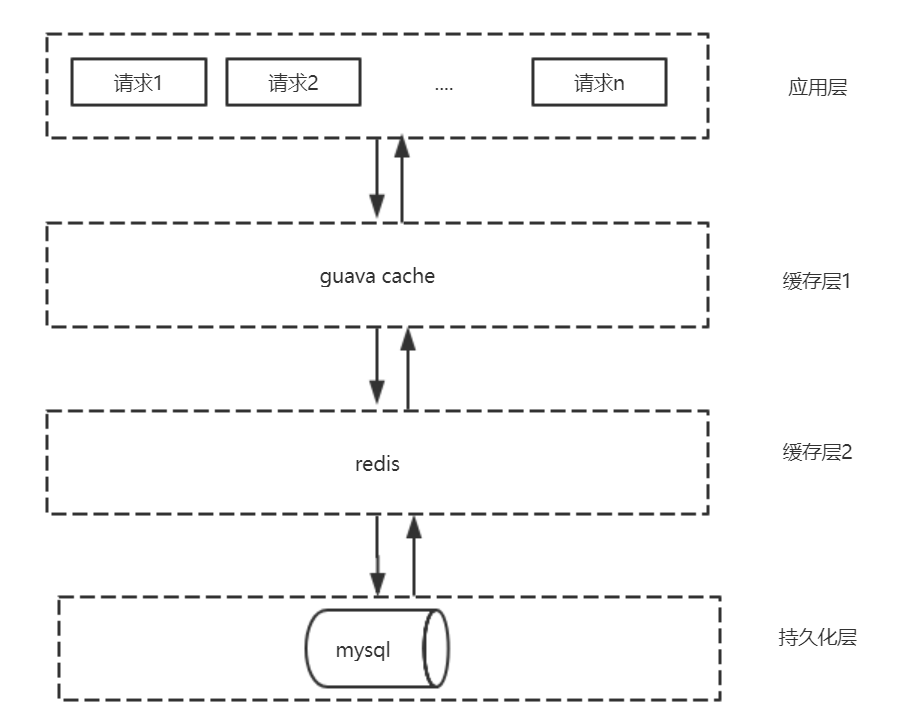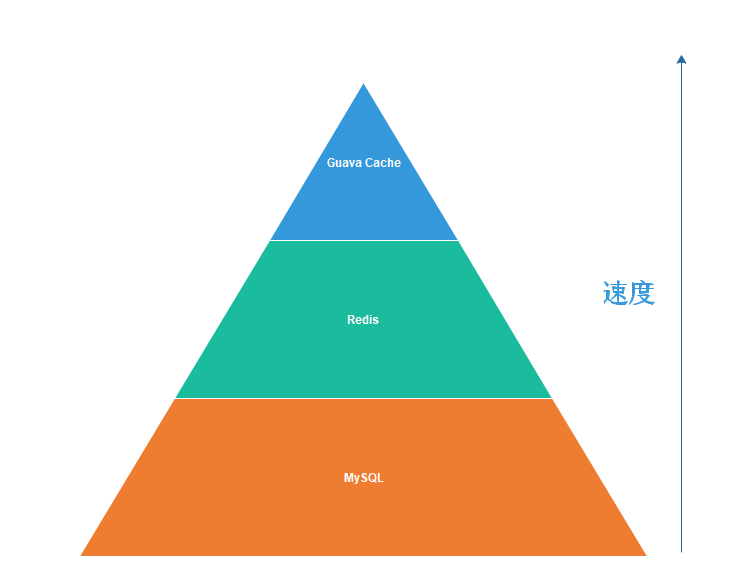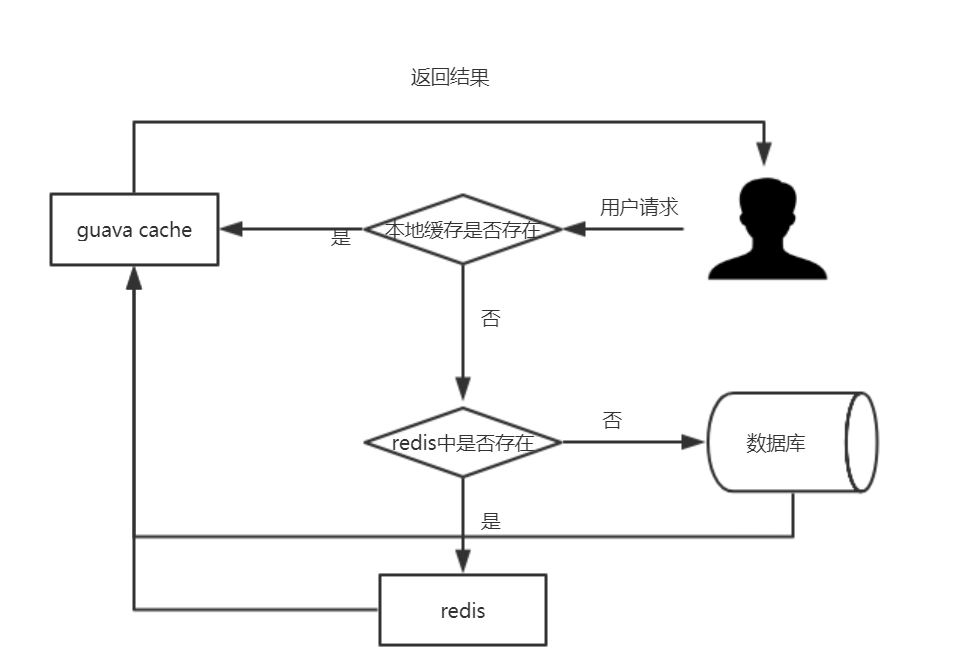查询mysql数据库时,同样的输入需要不止一次获取值或者一个查询需要做大量运算时,很容易会想到使用redis缓存。但是如果查询并发量特别大的话,请求redis服务也会特别耗时,这种场景下,将redis迁移到本地减少查询耗时是一种常见的解决方法
多级缓存基本架构

mysql、 redis和 guava cache。 mysql作为持久化, redis作为分布式缓存, guava cache作为本地缓存。二级缓存其实就是在 redis上面再架了一层 guava cahe
guava cache简单介绍
guava cache和concurrent hashmap类似,都是k-v型存储,但是concurrent hashmap只能显示的移除元素,而guava cache当内存不够用时或者存储超时时会自动移除,具有缓存的基本功能
封装guava cache
- 抽象类:SuperBaseGuavaCache.java
@Slf4j
public abstract class SuperBaseGuavaCache<K, V> {
/**
* 缓存对象
* */
private LoadingCache<K, V> cache;
/**
* 缓存最大容量,默认为10
* */
protected Integer maximumSize = 10;
/**
* 缓存失效时长
* */
protected Long duration = 10L;
/**
* 缓存失效单位,默认为5s
*/
protected TimeUnit timeUnit = TimeUnit.SECONDS;
/**
* 返回Loading cache(单例模式的)
*
* @return LoadingCache<K, V>
* */
private LoadingCache<K, V> getCache() {
if (cache == null) {
synchronized (SuperBaseGuavaCache.class) {
if (cache == null) {
CacheBuilder<Object, Object> tempCache = null;
if (duration > 0 && timeUnit != null) {
tempCache = CacheBuilder.newBuilder()
.expireAfterWrite(duration, timeUnit);
}
//设置最大缓存大小
if (maximumSize > 0) {
tempCache.maximumSize(maximumSize);
}
//加载缓存
cache = tempCache.build( new CacheLoader<K, V>() {
//缓存不存在或过期时调用
@Override
public V load(K key) throws Exception {
//不允许返回null值
V target = getLoadData(key) != null ? getLoadData(key) : getLoadDataIfNull(key);
return target;
}
});
}
}
}
return cache;
}
/**
* 返回加载到内存中的数据,一般从数据库中加载
*
* @param key key值
* @return V
* */
abstract V getLoadData(K key);
/**
* 调用getLoadData返回null值时自定义加载到内存的值
*
* @param key
* @return V
* */
abstract V getLoadDataIfNull(K key);
/**
* 清除缓存(可以批量清除,也可以清除全部)
*
* @param keys 需要清除缓存的key值
* */
public void batchInvalidate(List<K> keys) {
if (keys != null ) {
getCache().invalidateAll(keys);
log.info("批量清除缓存, keys为:{}", keys);
} else {
getCache().invalidateAll();
log.info("清除了所有缓存");
}
}
/**
* 清除某个key的缓存
* */
public void invalidateOne(K key) {
getCache().invalidate(key);
log.info("清除了guava cache中的缓存, key为:{}", key);
}
/**
* 写入缓存
*
* @param key 键
* @param value 键对应的值
* */
public void putIntoCache(K key, V value) {
getCache().put(key, value);
}
/**
* 获取某个key对应的缓存
*
* @param key
* @return V
* */
public V getCacheValue(K key) {
V cacheValue = null;
try {
cacheValue = getCache().get(key);
} catch (ExecutionException e) {
log.error("获取guava cache中的缓存值出错, {}");
}
return cacheValue;
}
}
- 抽象类说明:
- 1.双重锁检查并发安全的获取
LoadingCache的单例对象 expireAfterWrite()方法指定guava cache中键值对的过期时间,默认缓存时长为10smaximumSize()方法指定内存中最多可以存储的键值对数量,超过这个数量,guava cache将采用LRU算法淘汰键值对- 这里采用CacheLoader的方式加载缓存值,需要实现
load()方法。当调用guava cache的get()方法时,如果guava cache中存在将会直接返回值,否则调用load()方法将值加载到guava cache中。在该类中,load方法中是两个抽象方法,需要子类去实现,一个是getLoadData()方法,这个方法一般是从数据库中查找数据,另外一个是getLoadDataIfNull()方法,当getLoadData()方法返回null值时调用,guava cache通过返回值是否为null判断是否需要进行加载,load()方法中返回null值将会抛出InvalidCacheLoadException异常: invalidateOne()方法主动失效某个key的缓存batchInvalidate()方法批量清除缓存或清空所有缓存,由传入的参数决定putIntoCache()方法显示的将键值对存入缓存getCacheValue()方法返回缓存中的值
- 1.双重锁检查并发安全的获取
- 抽象类的实现类:StudentGuavaCache.java
@Component
@Slf4j
public class StudentGuavaCache extends SuperBaseGuavaCache<Long, Student> {
@Resource
private StudentDAO studentDao;
@Resource
private RedisService<Long, Student> redisService;
/**
* 返回加载到内存中的数据,从redis中查找
*
* @param key key值
* @return V
* */
@Override
Student getLoadData(Long key) {
Student student = redisService.get(key);
if (student != null) {
log.info("根据key:{} 从redis加载数据到guava cache", key);
}
return student;
}
/**
* 调用getLoadData返回null值时自定义加载到内存的值
*
* @param key
* @return
* */
@Override
Student getLoadDataIfNull(Long key) {
Student student = null;
if (key != null) {
Student studentTemp = studentDao.findStudent(key);
student = studentTemp != null ? studentTemp : new Student();
}
log.info("从mysql中加载数据到guava cache中, key:{}", key);
//此时在缓存一份到redis中
redisService.set(key, student);
return student;
}
}
实现父类的`getLoadData()`和`getLoadDataIfNull()`方法
* `getLoadData()`方法返回redis中的值
* `getLoadDataIfNull()`方法如果redis缓存中不存在,则从mysql查找,如果在mysql中也查找不到,则返回一个空对象
查询
- 流程图:
- 1.查询本地缓存是否命中
- 2.本地缓存不命中查询redis缓存
- 3.redis缓存不命中查询mysql
- 4.查询到的结果都会被load到本地缓存中在返回
- 代码实现:
public Student findStudent(Long id) {
if (id == null) {
throw new ErrorException("传参为null");
}
return studentGuavaCache.getCacheValue(id);
}
删除
- 流程图:
- 代码实现:
@Transactional(rollbackFor = Exception.class)
public int removeStudent(Long id) {
//1.清除guava cache缓存
studentGuavaCache.invalidateOne(id);
//2.清除redis缓存
redisService.delete(id);
//3.删除mysql中的数据
return studentDao.removeStudent(id);
}
更新
-
流程图:
- 代码实现:
@Transactional(rollbackFor = Exception.class)
public int updateStudent(Student student) {
//1.清除guava cache缓存
studentGuavaCache.invalidateOne(student.getId());
//2.清除redis缓存
redisService.delete(student.getId());
//3.更新mysql中的数据
return studentDao.updateStudent(student);
}
更新和删除就最后一步对mysql的操作不一样,两层缓存都是删除的
天太冷了,更新完毕要学罗文姬女士躺床上玩手机了
![69\_6.png][69_6.png]
最后: 附: 完整项目地址 上述代码在master分支上
=================以下内容更新于2019.01.18==============
基于注解的方式使用多级缓存
- 为什么需要提供基于注解的方式使用多级缓存
1:在不使用注解方式使用多级缓存,业务代码和缓存代码耦合,使用注解可以进行解耦,业务代码和缓存代码分开
2:开发方便 - 注解的定义
@Target({ ElementType.TYPE, ElementType.METHOD })
@Retention(RetentionPolicy.RUNTIME)
public @interface DoubleCacheDelete {
/**
* 缓存的key
* */
String key();
}
申明了一个@DoubleCacheDelete注解
* 注解的拦截
@Aspect
@Component
public class DoubleCacheDeleteAspect {
/**
* 获取方法参数
* */
LocalVariableTableParameterNameDiscoverer discoverer = new LocalVariableTableParameterNameDiscoverer();
@Resource
private StudentGuavaCache studentGuavaCache;
@Resource
private RedisService<Long, Student> redisService;
/**
* 在方法执行之前对注解进行处理
*
* @param pjd
* @param doubleCacheDelete 注解
* @return 返回中的值
* */
@Around("@annotation(com.cqupt.study.annotation.DoubleCacheDelete) && @annotation(doubleCacheDelete)")
@Transactional(rollbackFor = Exception.class)
public Object dealProcess(ProceedingJoinPoint pjd, DoubleCacheDelete doubleCacheDelete) {
Object result = null;
Method method = ((MethodSignature) pjd.getSignature()).getMethod();
//获得参数名
String[] params = discoverer.getParameterNames(method);
//获得参数值
Object[] object = pjd.getArgs();
SpelParser<String> spelParser = new SpelParser<>();
EvaluationContext context = spelParser.setAndGetContextValue(params, object);
//解析SpEL表达式
if (doubleCacheDelete.key() == null) {
throw new ErrorException("@DoubleCacheDelete注解中key值定义不为null");
}
String key = spelParser.parse(doubleCacheDelete.key(), context);
if (key != null) {
//1.清除guava cache缓存
studentGuavaCache.invalidateOne(Long.valueOf(key));
//2.清除redis缓存
redisService.delete(Long.valueOf(key));
} else {
throw new ErrorException("@DoubleCacheDelete注解中key值定义不存在,请检查是否和方法参数相同");
}
//执行目标方法
try {
result = pjd.proceed();
} catch (Throwable throwable) {
throwable.printStackTrace();
}
return result;
}
}
将注解拦截到,并解析出SpEL表达式的值并删除对应的缓存
* SpEL表达式解析
public class SpelParser<T> {
/**
* 表达式解析器
* */
ExpressionParser parser = new SpelExpressionParser();
/**
* 解析SpEL表达式
*
* @param spel
* @param context
* @return T 解析出来的值
* */
public T parse(String spel, EvaluationContext context) {
Class<T> keyClass = (Class<T>) ((ParameterizedType) getClass().getGenericSuperclass()).getActualTypeArguments()[0];
T key = parser.parseExpression(spel).getValue(keyClass);
return key;
}
/**
* 将参数名和参数值存储进EvaluationContext对象中
*
* @param object 参数值
* @param params 参数名
* @return EvaluationContext对象
* */
public EvaluationContext setAndGetContextValue(String[] params, Object[] object) {
EvaluationContext context = new StandardEvaluationContext();
for (int i = 0; i < params.length; i++) {
context.setVariable(params[i], object[i]);
}
return context;
}
}
对SpEL解析抽象出专门的一个类
* 原来的删除student的方法:
public int removeStudent(Long id) {
return studentDao.removeStudent(id);
}
该方法和原先相比没有了删除缓存的代码,删除缓存的部分都交给注解去完成了
最后: 附: [完整项目地址][Link 1] 上述代码在cache\_annotation\_20190114分支上



